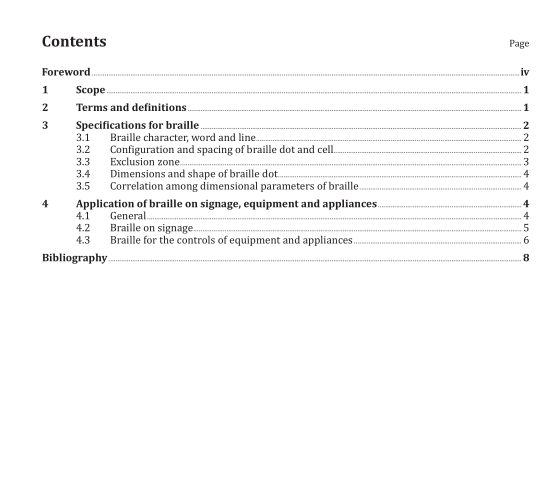BS ISO 17049:2013 pdf download.Accessible design — Application of braille on signage, equipment and appliances
This International Standard specifies the fundamental requirements for braille used on signage,
equipment and appliances, including the dimensional parameters of braille and the characteristics of
materials used, and the guidelines for practical implementation.
2 Terms and definitions
For the purposes of this document, the following terms and definitions apply.
2.1 signage
means of conveying information about name, direction, location, usage, safety or a form of action
2.2 equipment
permanent device or machine used in daily life in a house, an office or publicly accessible places EXAMPLE Such devices or machines include kitchen equipment, a copying or printing machine, an automatic teller machine, a ticket kiosk or a lift.
Note 1 to entry: In ISO 9999:2011, 6.3, and 18 30 03, the term “elevator” is used for lift.
2.3 appliance
movable device or machine used in daily life, such as an electric appliance for household or office use
2.4 tactile reading
recognizing braille and other tactile information by touch
2.5 tactile readability
ease of reading braille and other tactile information by touch
2.6 braille cell
space for the braille pattern, comprising up to six predefined dots set out in two columns of three
2.7 braille pattern
combination of raised dots within a braille cell
2.8 exclusion zone
area where nothing is placed around a braille cell or cells
2.9 button
operative device, such as pressure sensitive button, pressure sensitive surface, touch sensitive button,and touch sensitive surface Specifications for braille
3.1 Braille character, word and line
The braille character is composed of single braille patterns or a combination of braille patterns; the braille word is composed of one or more braille characters.
Braille patterns are all placed within the braille cell and they require the space of the braille cell. A braille cell requires the space of all six nominal dots. Vacant dots shall not be neglected because they are a part of the braille pattern.
Where a braille character or word appears in isolation, there shall be an exclusion zone around such a character or word.
Codes and format of braille characters, which are commonly used and recognized in each country,shall be adopted.
Braille shall be arranged to allow tactile reading to be performed consistent with the braille reading order in the language in which it is presented, e.g. left to right.
3.2? Configuration? and? spacing? of? braille? dot? and? cell
The configuration of braille dots and cells shall be in accordance with Figure 1; the spacing shown as a,b, p and q shall be in the range shown in Table 1.
Specifications should be in line with national or regional standards, if applicable.
The perpendicular height of braille dot centre, h, should be greater than 0,5 mm when used in outdoor
arrangement and on or in vehicles of means of transport.
3.5 Correlation among dimensional parameters of braille
Dimensional parameters of braille shall reflect the technical correlations between the individual parameters. For example if the smallest dot diameter and dot spacing are chosen, all other dimensions shall be proportional.
4 Application of braille on signage, equipment and appliances
4.1 General
Materials used for braille shall
— attain good tactile readability,
— have a surface and edge that will not cause harm when touched,
— be durable,
— not be damaged In normal use, and
— not be adversely affected by the external thermal environment, moisture or liquid.
Where braille and print are both used, the readability of one format shall not impair the readability of the other.
Braille shall be located on a place that is safe to touch. e.g. away from a source of heat or a sharp edge.
Where the information displayed in braille is revised, braille information shall be immediately
corrected accordIngly.
4.2 Braille on signage
4.2.1 General
Signage with braille shall be located in appropriate positions for easy access.
The number of cells in a single line shall be as follows:
a) if there Is only one column In one line, the number of cells shall not exceed 40;
b) if there are multiple columns In one line, the number of cells In one column shall not exceed 44) and the total number of cells shall not exceed 80 in a single line;
c) an exclusion zone of three or more cells shall be placed between each column in a single line.
4.2.2 Handrail
One application, among others, is on a handrail (see Figure 9.
Braille shall 1w dIsplayed parallel to the longttudrnal direction of a handrail.
Braille shall be displayed on the area where it can be most easily read, and which allows safe reading by touch when a hand holds the handrail, Such an area should he chosen by considering the shape, thickness, surroundings and the method by which the handrail is fixed.
For a handrail on stain, braille should be displayed at the end of the handrail, which is an extension of tactile walking surface indicators (TWSI) (see ISO 23599). if any, on the floor in front of the stairs.
liandralis with braille should have extensions, preferably of at least 300 mm In length on both ends of the staircase; this is to allow for safe reading of braille.BS ISO 17049 pdf download.BS ISO 17049-2013 pdf download
